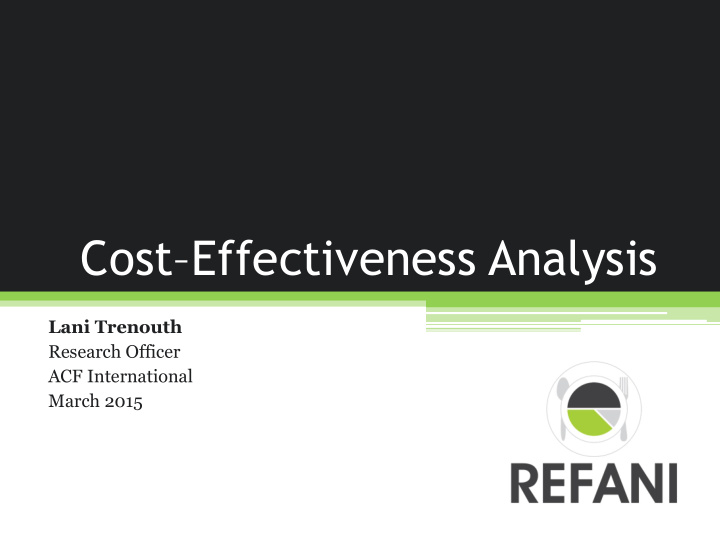



Cost – Effectiveness Analysis Lani Trenouth Research Officer ACF International March 2015
What is Cost-Effectiveness Analysis? • Economic analysis to compare the relative total costs and effects of two or more interventions • Typically expressed as a ratio - total programme resources divided by the “effectiveness” or outcome achieved • Output / direct deliverables >>> Cost efficiency ▫ e.g. cost per beneficiary reached • Outcome / changes in wellbeing >>> Cost effectiveness ▫ e.g. cost per case of diarrhea averted
Why Cost-Effectiveness Analysis? • Provide evidence to inform policy decisions regarding competing demands for limited resources • To inform program management, guidance for decision- making for resource allocation, expected costs • Move beyond cost efficiency; cost efficient ≠ cost effective • To fill the gap of existing knowledge on cost-effectiveness and support the definition of benchmarks for food assistance cost- effectiveness
Existing Evidence • Extensively used in the field of health care; since mid- 1960s • Large evidence gap on cost-effectiveness of food assistance • More evidence on cost-efficiency, e.g. cost per BNF, cost- transfer ratio, etc. ▫ CaLP /OPM 2014 Guide to calculating cost of delivering cash transfers in humanitarian emergencies – Kenya and Somalia ▫ Gentilini 2014 Our Daily Bread: What is the evidence on Comparing Cash versus Food Transfers?
Analytical Perspective TOTAL PROGRAM COSTS financial and economic ACF Beneficiaries Institutional Societal Partners Community (government, private sector, UN, other NGOs…)
CEA Inputs Institutional costs Societal costs Staff salary & time use Beneficiary wage loss Supplies, vehicles, rent & Beneficiary transport fees utilities Community volunteer time Program inputs (value of cash Community in-kind donations and vouchers) (e.g. venue for distributions) costs effects # children recovered # cases averted
Methods – Data Sources • Accounting data • Staff interviews with implementing organisations and partners • Focus group discussions with beneficiaries • Key informant interviews with community leaders, vendors, service providers
CEA Outputs • Average cost- costs effectiveness ratio effects • Incremental cost- costs p1 – costs p2 effects p1 – effects p2 effectiveness ratio • Cost structure over time • Cost structure across “cost centres ” • Sensitivity analysis
REFANI CEA Objective and Outputs • Complement nutritional impact studies, adding value-for-impact evidence • Primary output: comparative CEA of C&V food assistance in prevention of acute malnutrition • Secondary outputs: derive cost per beneficiary, cost per activity, cost-transfer ratios, proportion of cost centres, cost drivers
Thank you Lani Trenouth Research Officer ACF International March 2015 ltrenouth@actionagainsthunger.org
Recommend
More recommend